Understanding “Untuk Negeri Kita”: the making of Penang's state anthem
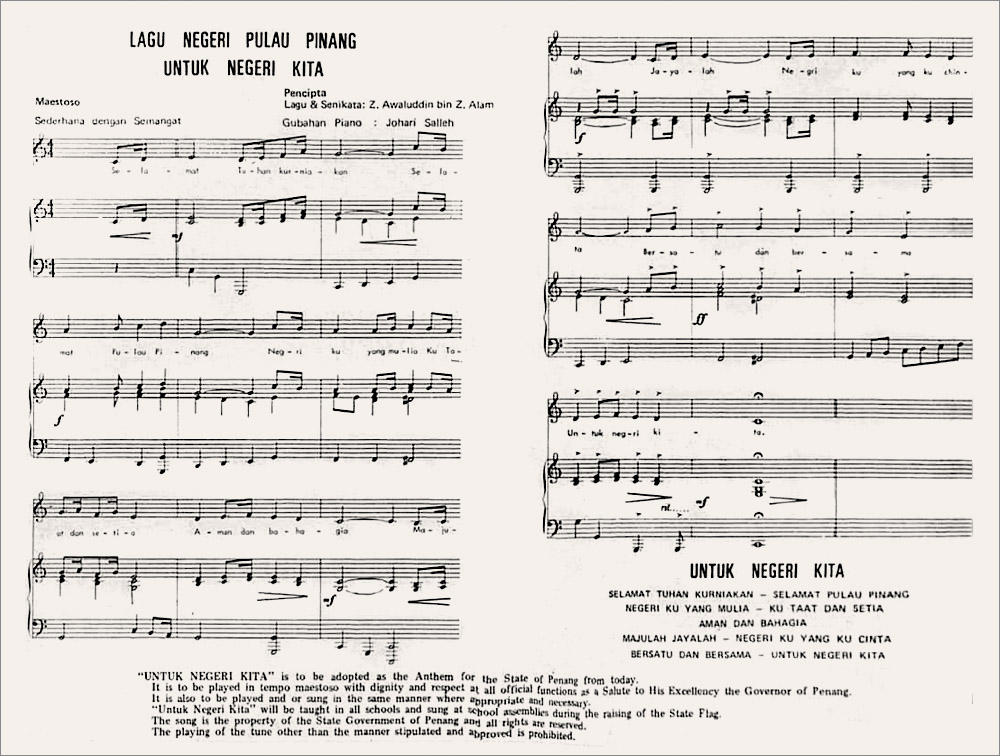
The score of "Untuk Negeri Kita" by Awaluddin Zainal Alam.
For more than half a century, the state anthem, "Untuk Negeri Kita" (“For Our State”), has been more than just a ceremonial tune. For me, it was the song that opened every school assembly at La Salle Primary School and later echoed through the colonial hallways of St. Xavier's Institution during my secondary years. We sang it with pride, unaware of the layered history behind its creation.
It was only in 2022 that an article in Buletin Mutiara that the fuller story came into view, thanks to the research shared by Paul Augustin from the Penang House of Music. And like many stories wrapped in tradition, this one is worthy of a thoughtful revisit.
The need for a Penang anthem
After Merdeka in 1957, Penang continued to use a shortened version of the national anthem, "Negaraku", at official functions.
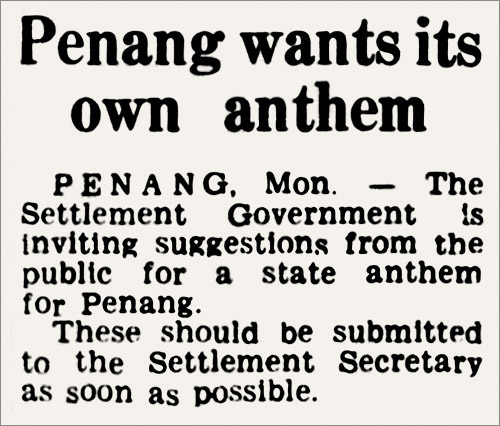
A news article in the Straits Times which was published on 23 July 1957 invited suggestions for a Penang state anthem to be submitted to the Settlement Government. However, whether it was successful or what transpired after the notice in the newspapers is unrecorded.
The idea for the state anthem was once again revived 15 years later in 1972, when Dato' Harun Sirat, then Speaker of the State Assembly, launched a formal competition to create a song that would reflect Penang's identity.
A committee was formed to organise the competition. It was headed by Dato' Harun himself, with Khoo Teng Chye, Abdul Rahman Yunos, D.C. Stewart, Ismail Hashim, Dr S.P. Chelliah, Khoo Soo Giap, Zainal Alam, Dr Khoo Kim Chgn, Khoo Boon Beow (as secretary until 1 March 1972) and Abdul Majid Nor Mohamad (from 1 September 1972) as members.
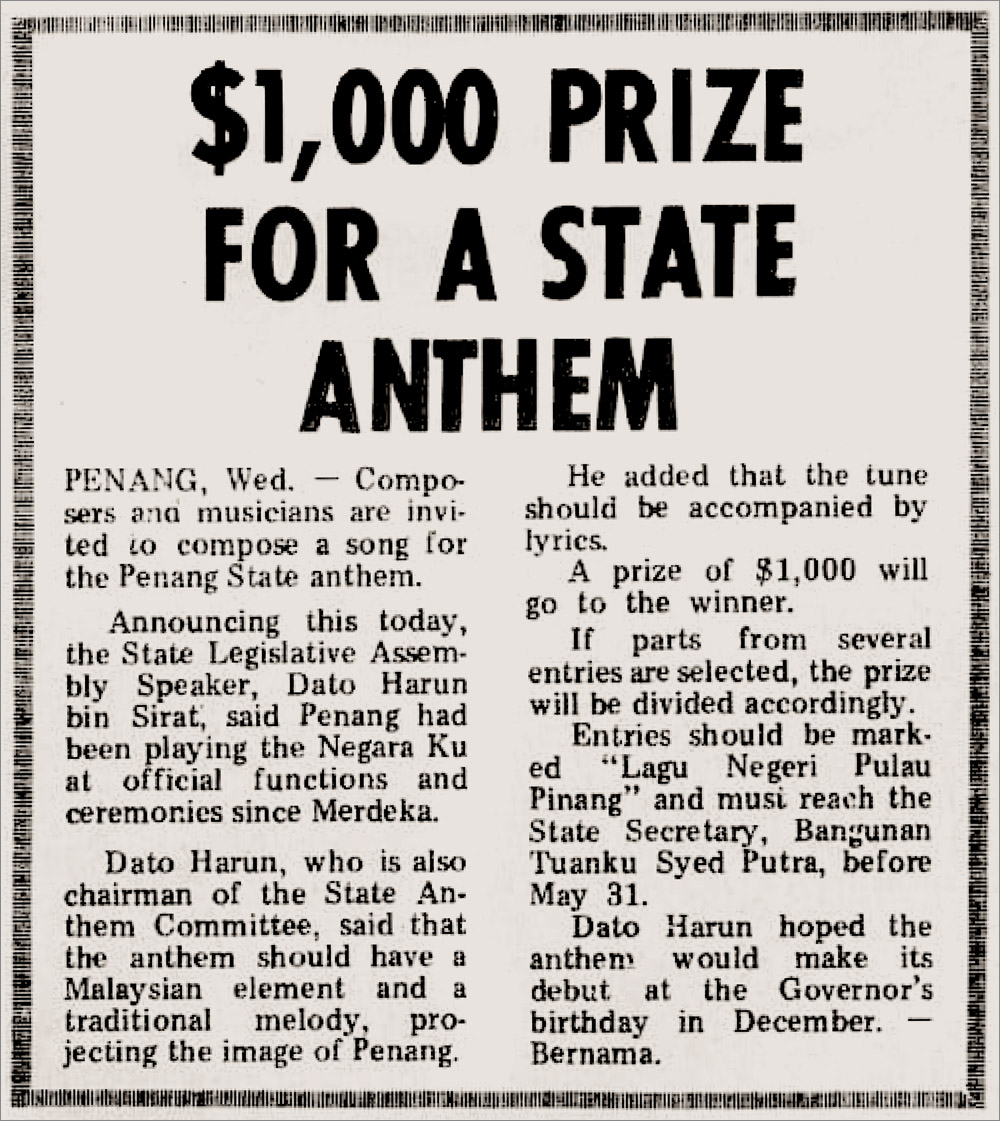
A news article published in The Star on 2 March 1972.
The competition offered a RM1,000 prize and called for a song with a "Malaysian element and a traditional melody". Over 40 submissions were received. The committee shortlisted 10 entries for a panel of judges to recommend three songs to the state government for final selection.
The panel of judges comprised Yang Amri Kamaruddin, who was then the State Secretary as chairman of the panel; Johari Salleh, leader of Radio/TV Malaysia’s orchestra; Ariff Ahmad, a senior cultural officer attached to the Ministry of Culture, Youth and Sports; I.K. Cheah, a renowned Penang lawyer and musician; Abdul Rahman Yunos, the then state assemblyman for Balik Pulau (who replaced Ismail Hashim, who was then away to the United Nations).
Dato' Harun also gave special thanks to Johari for arranging the three selected songs to give them equal treatment before the state government made its final selection.
On 15 November 1972, the state exco went to the auditorium of Radio Malaysia in Penang to listen to the three recommended songs. As the news report said, the state exco, after listening and discussing for more than an hour, picked the song "Untuk Negeri Kita" as Penang’s state anthem.
The winner: Awaluddin Zainal Alam
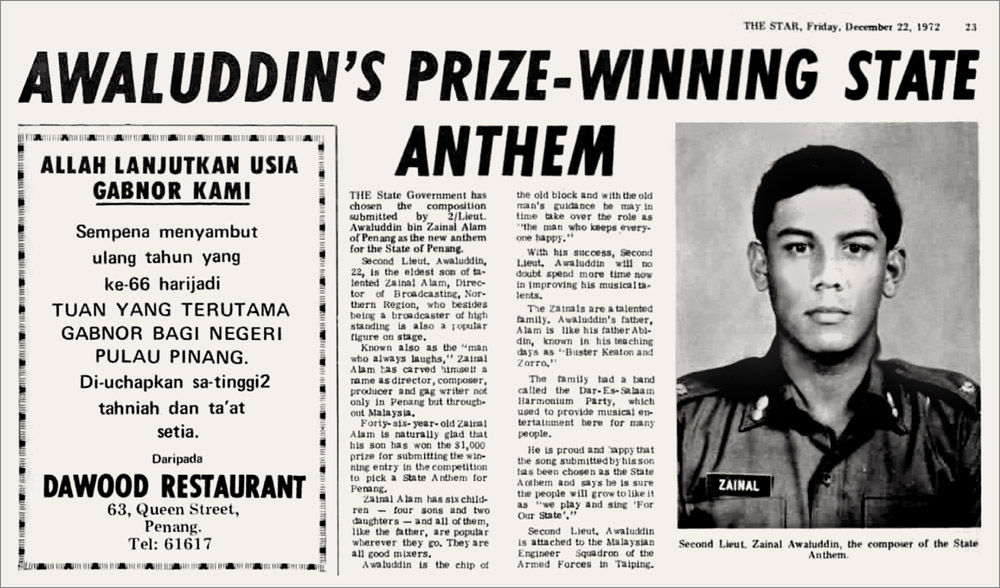
The Star, 22 December 1972, announcing Awaluddin as the winner of the Penang State Anthem competition.
The winner of the competition was 22-year-old Second Lieutenant Awaluddin Zainal Alam, son of RTM Penang’s broadcasting director and popular master of ceremonies, Dato’ Zainal Alam. Awaluddin’s winning piece was a solemn, melodic prayer for unity and peace, capturing the aspirations of a newly self-defining state.
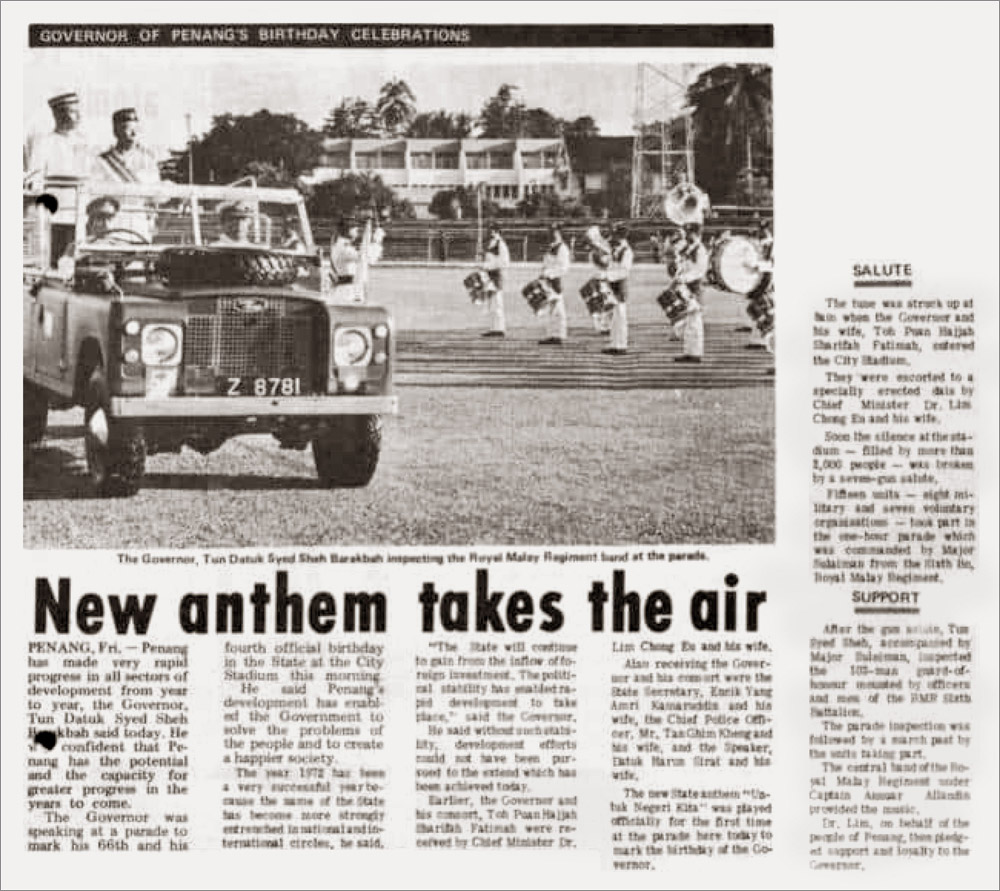
An article in The Star, published on 23 December 1972.
The song was first performed at City Stadium on 22 December 1972 during the 66th birthday celebrations of the Governor, Tun Syed Sheh Barakbah.
The committee and a question of conflict
Here is where the story demands scrutiny. Among the organising committee overseeing the competition was Dato’ Zainal Alam, Awaluddin’s father. In today’s terms, this would be considered a conflict of interest. While there is no documented evidence that Zainal Alam directly participated in the final judging, his involvement in the organising body warrants consideration of procedural transparency. Was there a recusal? Were the submissions anonymised? If not, could familial influence, intended or not, have tipped the scales?
The rejection of a musical giant
Enter Jimmy Boyle, Penang-born, Eurasian and arguably one of Malaysia’s most accomplished composers. His musical fingerprints can be found across decades of national and institutional pride. Boyle composed for the Technical Institute Penang, Universiti Sains Malaysia (USM), RAAF School Penang, Sukan Sekolah-Sekolah Malaysia, Road Safety ("Ingat-Ingat") and even the first Malaysian Scout Jamboree in 1966, for which he wrote the rousing "Bersatu Jaya". His prolific output helped shape the soundscape of a young, post-colonial Malaysia.
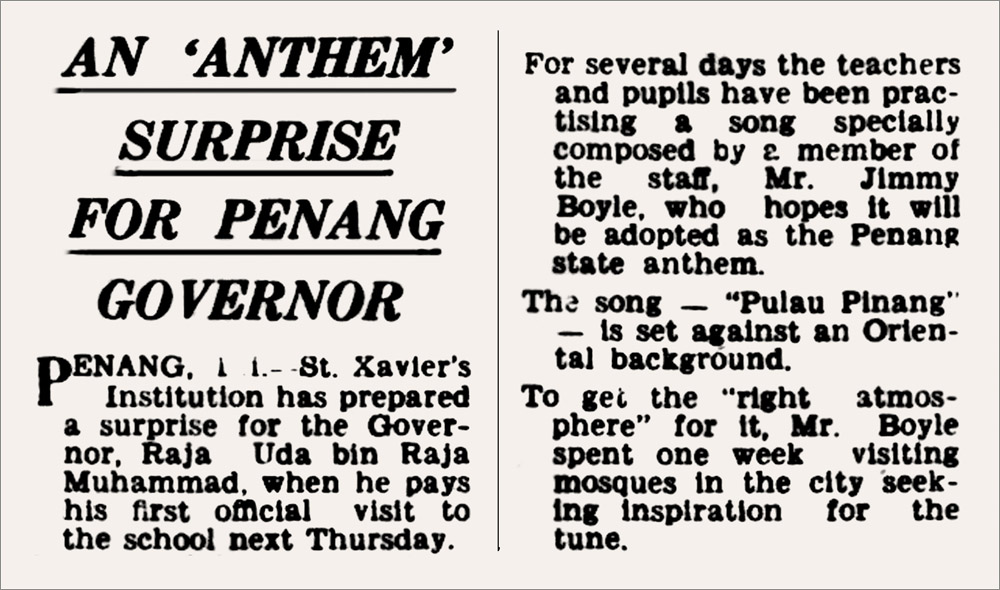
The Straits Times, 20 September 1958, Page 7, reporting an ‘anthem’ surprise for the Penang Governor during his official visit.
In the early days of Malaya's independence, Boyle was already sowing seeds of musical patriotism. On 20 September 1958, The Straits Times ran a story titled "An 'Anthem' Surprise for Penang Governor". It revealed that Boyle, then a teacher at St. Xavier’s Institution, had composed a piece titled "Pulau Pinang" to honour the official visit of the Governor, Raja Uda bin Raja Muhammad. The school had rehearsed the piece in secret, intending to surprise the Governor with Boyle’s hopeful offering for a state anthem. The article added a fascinating detail that Boyle had spent a week visiting mosques across George Town, immersing himself in their melodies to capture what he described as the “Oriental background” of Penang’s soul.
Selecting a state anthem is no minor task as it reflects the collective identity of a people. If a filmmaker were in search of an epic score, they would turn to the likes of John Williams, Hans Zimmer or Joe Hisaishi, all masters in their field known for composing powerful and enduring music. They would not hold a public contest. And yet, that was precisely how Penang's state anthem was chosen. While the process may have appeared democratic, one cannot help but wonder why Jimmy Boyle, already one of the nation's most accomplished composers, was not entrusted with the honour. After all, the country was not short of musical talent at the time, with contemporaries like P. Ramlee, Ahmad Nawab and Ooi Eow Jin, any of whom could have been entrusted with the task.
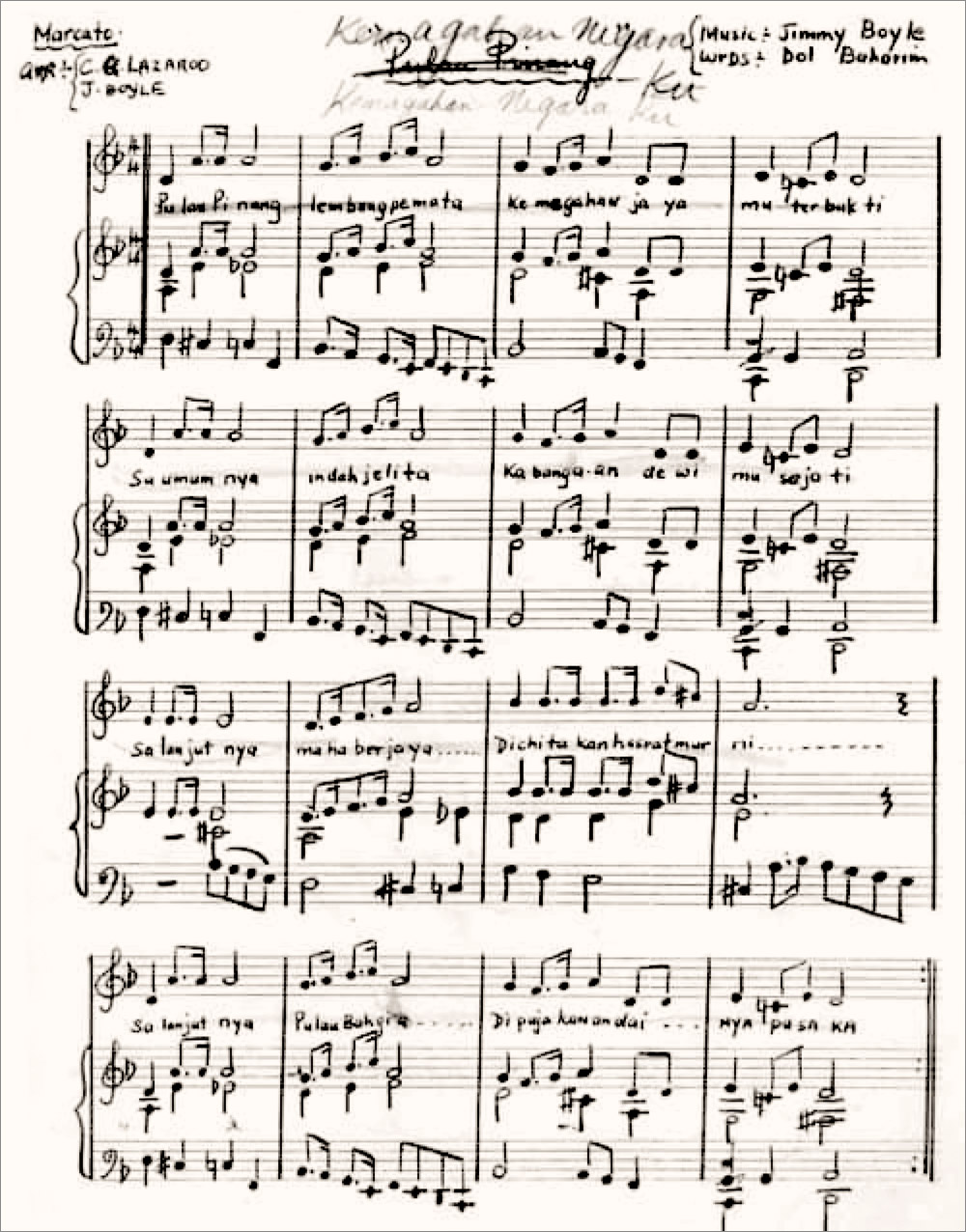
Why was Boyle’s "Pulau Pinang" not adopted? Who made the call? Was it stylistic preference, politics or simply the whim of an individual? These are uncomfortable but necessary questions. Paul Augustin shared a music score showing the title "Pulau Pinang" scratched out by Boyle’s own hand and replaced with "Kemegahan Negaraku", which has become a celebrated patriotic song for the nation today.
In an article after Boyle’s unexpected heart attack that took his life, his mother, Mrs J Boyle noted in an article in the New Straits Times, 11 May 1971; "His proudest moment came on 31 August 1957 when Merdeka was proclaimed at Kuala Lumpur. The "Negara Ku" was not ready yet and when the first Malayan flag was raised, it was to one of Jimmy's tunes."
History is often written by those who prevail, but legacy is shaped by those who dared. Boyle dared and though he was not chosen, his music continues to echo across time and institutions. Had his anthem been selected, Penang’s musical identity might have sounded profoundly different.
A shift in tempo
An anthem, by nature, is not just a song. It is the distilled emotion of a people, a reflection of their history, pride and aspirations. Its tempo, cadence and mood carry deep cultural and symbolic meaning. To alter it is to reshape the very sentiment it was meant to convey.
Originally composed in a slow, reverent tempo, the anthem was altered in 1993 under the then Chief Minister Koh Tsu Koon. The updated version is faster, more energetic to reflect Penang’s development push and transformation into a bustling economic hub.
However, was this truly necessary? Who rearranged the beat of state anthem? I invite every Penangite to listen to both versions. Evaluate them not just with your ears, but with your heart. Do we stand taller with the energetic new arrangement, or have we lost something majestic? As for me, I much prefer the original as its solemnity carried a quiet dignity, a reverence that mirrored the soul of Penang. Some songs should not be hurried. Yet, my daughter loves the faster tempo, calling it more uplifting and hopeful.
This shift in tempo echoes another controversy: Malaysia’s national anthem, the "Negaraku". In 1992, it too was given an upbeat facelift that was widely criticised and eventually abandoned. In 2003, the government even proposed renaming it to "Malaysiaku", a move that sparked national outcry and was swiftly reversed.
A spirit still in song
Despite the surrounding these questions, "Untuk Negeri Kita" has become a cherished part of Penang’s civic life. Its melody and recognisable lyrics resonate with a shared sense of identity, especially for those of us who grew up singing it.
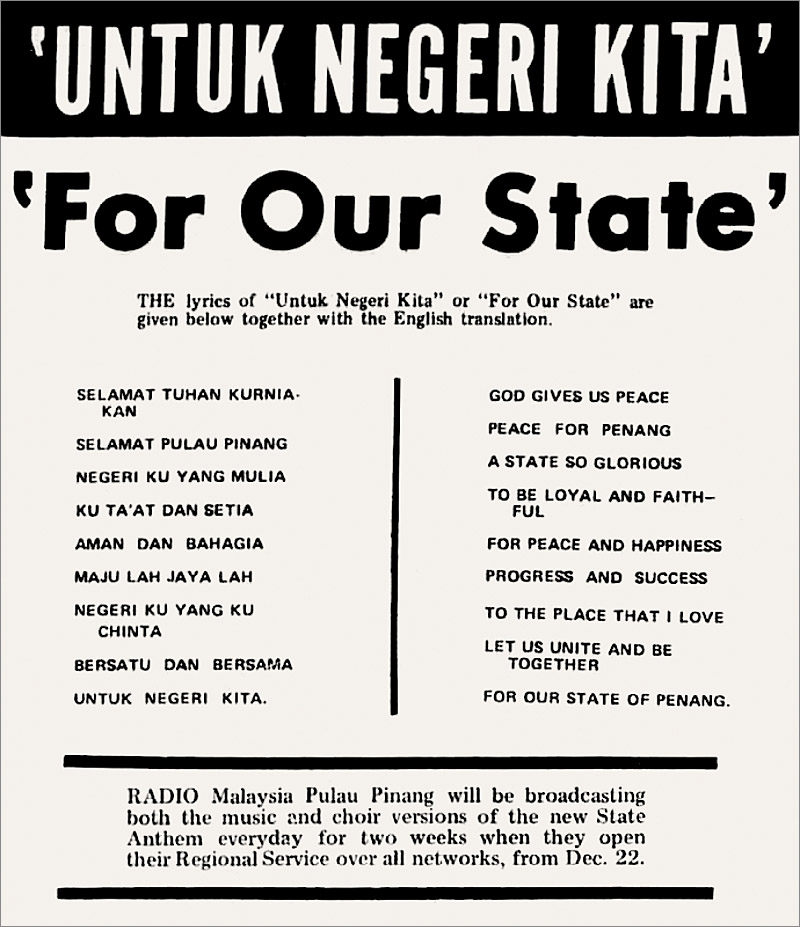
Here is the lyrics of " Untuk Negeri Kita" in Malay followed by an English translation:
Selamat Tuhan kurniakan,
Selamat Pulau Pinang,
Negeriku yang mulia,
Ku taat dan setia,
Aman dan bahagia,
Majulah, jayalah,
Negeriku yang ku cinta,
Bersatu dan bersama,
Untuk negeri kita.
Translation:
May God grant safety,
Safety to Penang,
My noble state,
To which I am loyal and faithful,
Peaceful and happy,
Progress and succeed,
My state which I love,
United and together,
For our state.
May “Untuk Negeri Kita” continue to uplift each generation of Penangites, reminding us to stand united in the pursuit of peace and a brighter tomorrow.
---------------------------------------------------------
Written by Adrian Cheah
Photographs: Paul Augustin and open sources © All rights reserved
6 August 2025
PS: For those curious about the anthems sung in Penang before “Untuk Negeri Kita” was introduced:
• Straits Settlements (1826–1941): God Save the King (or God Save the Queen, depending on the monarch at the time)
• Japanese occupation (1941–1945): Kimigayo
• Crown colony of Penang (1946–1957): God Save the King until 1952, and subsequently God Save the Queen from 1952 until Penang joined the Federation of Malaya in 1957.
Reference:
"The Story Behind the Penang State Anthem" – Buletin Mutiara, 2022
---------------------------------------------------------
Here are a few renditions of the Penang State Anthem:
Untuk Negeri Kita 2025 (Official Penang State Anthem)
Penang State Anthem by Chelsia Ng
Bihzhu – “Penang State Anthem (#PenangIsProject)”